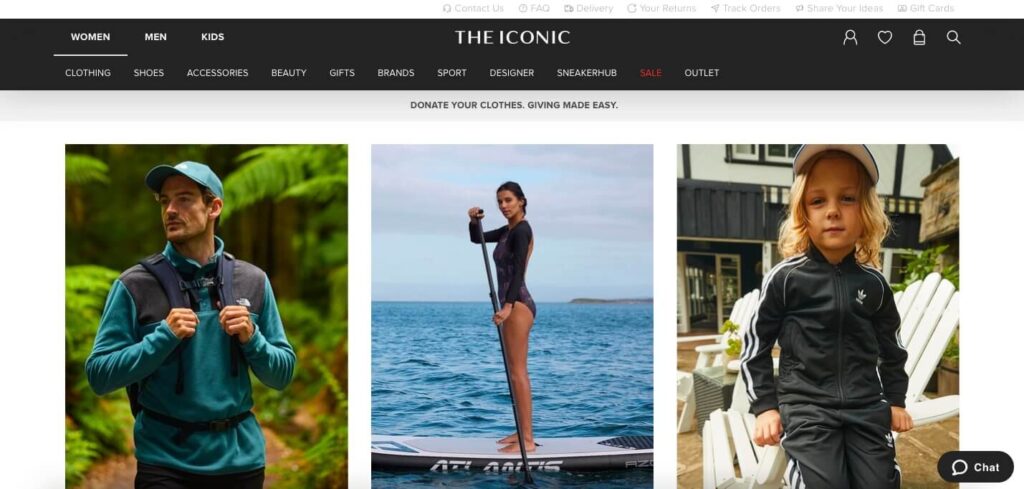5 Ecommerce Site UX Problems That Are Killing Your Conversions (and How to Fix Them)

What is an eCommerce site UX? And how does it relate to your website’s conversions?
UX stands for User Experience, and it includes all the factors that provide your eCommerce customer with a pleasant and memorable shopping experience. UX begins from the moment a user clicks onto your website, so understanding what aspects will enhance your visitors’ experience is extremely important.
Conversions are the visitors to your eCommerce site that actually follow through with purchases and become customers. The number of conversions your website has defines the success of your business, so understanding how UX drives these is the key to optimising your website for maximum marketing results.
- Get your website Ranked No.1 on Google with KWD SEO Auckland
Focusing on UX means focusing on your website’s infrastructure and technology and then making adjustments and improvements to better cater to your customers’ needs. No matter how outstanding your products are, if your customer is not having a positive experience, they will not stay on your site.
Here are the most important components for a thriving eCommerce site UX:
- A seamless user experience from the start.
- Attractive and intelligent design.
- Use- friendly site navigation.
- A smooth checkout process.
- Fast and responsive site speed.
Identifying problems that are killing your eCommerce site conversions and systematically resolving them will enable you to convert your site’s traffic into repeat customers.
Have you ever wondered why 76 out of every 100 of your visitors end up abandoning their cart? It’s because they simply weren’t impressed! Remember, you are selling the experience before the product!

Let’s take a look at 5 of the biggest eCommerce site UX problems that are killing your conversions and what you can do to prevent them:
Flaws In The Website Design
The layout and design of your eCommerce website is your connecting portal that makes the first correspondence with your customers. Choosing a visually literate layout will welcome visitors to your store, and the integration of interactive tools to your site will encourage them to stay.
You would be surprised by how many websites overcomplicate this interface and forget to make their website a clear and user-friendly place to be. Some of the most common mistakes website developers make in the UX of an eCommerce website are found in the design processes.
Here are a couple of good examples:
- Developing websites that are not mobile-responsive – This hinders traffic to your website.
- Little or no user engagement – This affects the conversion of your site traffic into real customers.
How To Fix This UX Problem:
- Be Mobile Friendly
Developing your eCommerce site UX through optimising a mobile friendly platform not only increases your traffic but encourages visitors to stay on your website. Kissmetrics stats tell us 38% of mobile internet users say they’ve encountered a website that wasn’t available to them when using their mobile – being part of that statistic can easily be avoided.
Implementing a well-designed eCommerce website that is mobile optimised automatically takes that 38% of mobile internet users and directs them towards your website, bumping your business above your competitors instantaneously.

- Use Interactive Tools
With 1.4 billion people using messaging apps, it’s not surprising to learn 41.3% of consumers used chatbots for purchases in 2020. Chatbots are changing the eCommerce site UX in a leading way, they quickly and efficiently solve customers’ queries and concerns 24 hours a day, 7 days a week, which means they’re consistently converting your site traffic into genuine customers. When you optimise the UX, you systematically break down potential barriers customers may face when contemplating a purchase.
Operating Chatbots is like having a sales rep available around the clock. They interact and chat with customers on demand. Research has proven 55% of businesses using chatbots have generated a greater volume of high-quality leads. This shows the impact an intuitive UX tool has on your eCommerce website.
Limited Product Information
The readability of your product information has a big impact on your eCommerce site UX. Web designers commonly overlook the construction of this component, and a surprising 46% of people get it wrong.
Keeping your site simple is important, but keeping it too simple can actually cost your customers. Here are the most common mistakes made in the format and composition of product information and how they potentially affect eCommerce site UX:
- Failing to create transparency in the product details – By doing this, you prevent visitors from attaining the information they need in order to follow through with a purchase.
- Failing to personalise product recommendations to customers – This limits your sites ability to promote other areas of your business and cross-sell products.
How To Fix This UX Problem:
- Know Your Customer
Understanding what your customer is looking for on your eCommerce website should be the driving force in the design and layout of your product pages and product descriptions.
Consolidating and optimising your product descriptions to include keywords about your products or services will amplify your content and UX. By doing this, your customers are assured that they are in the right place. Setting your product or service description up with a clear price and an easy to follow description of what you are selling will provide clear and concise solutions to your customer.
Writing your product or service description in a clear and concise manner with
The accuracy of your content in the product or service descriptions will generate conversions from site traffic to genuine buyers. As Neil Patel says, you need to ‘sell benefits, not features.’
Here is an example of how this eCommerce website provides a clear description of a pillow designed specifically for allergy sufferers. Take note of how the content is personalised to the buyer:

- Personalise Your Ecommerce Website
When 80% of consumers are more likely to do business with a company that offers a personalised experience, you can see that the key to driving conversions is through the construction of your product pages.
A great place to start is defining your visitors, who they are, what they are looking for, and how you can convert them into buyers. When you understand your visitors’ needs, you can better optimise the presentation and detail of your products, catering to a broad range of customers.
The use of keywords in your product descriptions will lead customers to where they want to go, and further suggesting related products will provide them with a greater variety. Reaching out to your visitors is a great way to build trust and rapport within your business. It not only keeps visitors on your site, but it assures them you have what they need. When a customer has a memorable experience with your eCommerce store, they are more likely to come back.
Here is an example of how Amazon encourages its customers to check out similar products on its website:

This type of Basic personalisation can give you an 8% sales uplift and is achieved just by knowing your products and using them intelligently to interact with your customers.

Site navigation
First impressions are everything! They are the beginning of your customers’ UX of your eCommerce website. That is why the navigation of your platform needs to be coherently designed with the customers initial reaction in mind. When 42% of mobile eCommerce sites fail to have a homepage design that enables users to identify the type of site they’ve landed on accurately, it is a clear indication that site navigation is not often prioritised.
Two of the most important factors to consider in the layout of your website should be:
- Developing A Relevant And Logical Homepage
The first page of your eCommerce website is an introduction and snapshot of the products or services you’re offering. Knowing 70% of users scroll up and down your homepage before going anywhere on your site confirms just how important it is to make your homepage engaging and informative.
Creating an impressive design and theme for your website is detrimental. Your homepage either confirms or denies whether you have what your visitors are looking for. Here is an example of an eCommerce website homepage that has used a combination of bold images to show customers what they are selling:

We can see by this layout, the designers have prioritised visual components. The composition and layout of the chosen images have been skillfully considered in order to tell the story of the brand. The design of this homepage leaves very little room for confusion and gives visitors instant gratification in that they’ve found the right place.
Your website’s homepage should convey precisely what you are offering without visitors needing to scroll excessively. Presenting your business and its products simply and effectively will optimise your eCommerce site UX greatly.
- The Layout Of Your Products
Knowing that 57% of internet users won’t recommend a business with a poorly designed website proves the layout and organisation of your eCommerce website is vital in achieving marketing results. Following a clear and concise layout will not only make your website user-friendly but will accurately improve the UX of your eCommerce website, fast-tracking the conversions of site visitors into genuine customers.
Perfectly optimising your pages will visually benefit your customer and promote your content in the broadest way possible. A good start is to check whether your products are clearly labelled with relevant and appropriate headings, allowing site visitors to quickly find what they are looking for.
Here is a good example of how you can use visual tools to steer customers through your products. Note how the top banner simplifies the navigation of this eCommerce website:

Check out process
The checkout process is the grand finale for your eCommerce site. Adapting best practice methods will maximise your conversions and ensure your customers have a positive UX.
The end goal of your website is to make sure customers can complete their purchases before they have a chance to change their minds.
Here are our key tips for creating a smooth sailing checkout experience for your customer:
- Give your customer options – This can include offering a guest checkout. Guest checkouts are arguably the most important step in your eCommerce business. They require a lower level of commitment from shoppers and have been proven to make a 20-60% reduction in the chances of shopping cart abandonment.
- Limit the clicks – Making your checkout simple and easy to use will decrease cart abandonment. Seamlessly allowing customers to complete their purchase in under 3 clicks will significantly improve your conversions. The eCommerce site ASOS simplified its checkout process by limiting the clicks required to complete a sale, resulting in decreased cart abandonment by 50%.
- Optimise for mobile devices – Being mobile-friendly compliments the UX of your checkout process. Having a mobile optimised eCommerce site will increase your conversions through your site’s availability and portability. Almost 40% of all eCommerce purchases during the 2018 holiday season were made on a smartphone – These statistics should be enough evidence to know the value of a mobile optimised checkout process.

Slow site speed
Slow site speed is a hazard that can potentially cripple your site conversions. The speed of your website either increases or decreases your visibility on Search Engines like Google, so getting your website up and running efficiently will improve the visibility of your business.
According to research, 40% of people abandon a website that takes more than 3 seconds to load, so proactively keeping on top of your site speed is crucial. Factors such as broken links, wrong image size, a limited capability CMS and a mediocre web host are amongst the mitigating factors slowing down your website. With a focus on UX and conversions, site speed couldn’t be more important.
How Can You Fix This
The best way to check your site speed is by using the tool Google Page Speed Insights. This will give you an accurate idea of how your site is performing and the speed at which it should be.
It is important to know that some Content Management Systems (CMS’s) were designed specifically for eCommerce sites and others were not. So choosing the right website design team is a vital component for creating solid foundations for your website.
If you’re not sure where to start, we would recommend a free website audit, this will diagnose potential issues and limitations your site is facing, enabling you to see what needs improving.

The Bottom line
Presenting your business and your products in an effective way is going to increase your site conversions. It will create a positive and memorable experience for customers visiting your eCommerce site.
Our Takeaway Points To Remember:
- Create a seamless and user-friendly home page for your website.
- Invest in the design and layout of your content.
- Make sure the navigation of your site is simple and easy to follow.
- The checkout process seals the deal. Make this process as easy as possible.
- Your site speed is the make or break for visitors entering your site.
- Choose a reputable and professional website design company. Investing well at the start makes a world of difference.
Getting a new website is a good investment for your business, and choosing the right website design team is essential in creating a profitable eCommerce website. Investing in the right website design will improve your site’s performance and ensure you’ll see real marketing results and will be reaching your ideal sales.
You May Also Like
- Tip for Effective Product Description Writing
- E-Commerce Website Design Elements 2022
- Best Email Marketing Tips to Increase Engagement


Comments are closed.